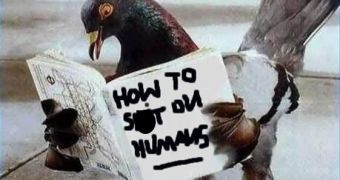Pigeon droppings deface and accelerate the deterioration of buildings and increase the cost of maintenance. Large amounts of droppings may kill vegetation and produce an objectionable odor. Pigeon manure deposited on park benches, statues, cars, and unwary pedestrians is aesthetically displeasing.
Liverpool council has decided to launch an initiative designed to scare off pigeons, considered a nuisance, and help clean up the city.
The pigeon problem has been exacerbated by residents in the city feeding the birds - whose natural diet is seeds and insects - with take-away leftovers. "We need to get the message across that anyone who feeds the birds intentionally, or occasionally with leftovers such as sausage rolls or burgers, is responsible for our streets being so crowded with these birds," Berni Turner, Liverpool city councils executive member for the environment, said.
To do so, a flock of robotic falcons has been dispatched to tackle an influx of obese pigeons that are increasing in number and size thanks to an unnatural diet of fast-food.
The mechanical birds - called "Robops" - have been placed on rooftop locations around the British city and will flap their wings and squawk loudly to scare the problem pigeons away.
The falcons, created by a Scottish company, resemble peregrine falcons, the natural predators of pigeons. As a result of the scaring techniques and people not feeding the birds, it is hoped that the pigeon population will move out of the city center and into Liverpools parks and green spaces.
Liverpool has been named the European Capital of Culture in 2008, but the city council currently uses the equivalent of 88 man-hours a day cleaning droppings from streets and buildings, at a cost of 160,000 pounds ($320,000) a year.
Although some citizens expressed their concern over the costs of this new method, a world statistic shows that pigeons are more "expensive" than one might think:
Structures inhabited by pigeons can sustain damage from droppings and harbor disease. The droppings can also make structural surfaces slick and hazardous to walk or climb on.
Washing acidic accumulations of droppings to prevent structural damage can cost in excess of $10,000 per year, per building. The longevity of industrial roofing materials can be adversely affected by droppings, resulting in expensive replacement costs.
Employee health claims and lawsuits resulting from diseases or injuries attributed to pigeons can easily exceed $100,000.
So, it seems that an integrated pigeon management program incorporating lethal and non-lethal control applications is well worth the investment when considering the economic damage and health threats caused by large populations of pigeons.

 14 DAY TRIAL //
14 DAY TRIAL //